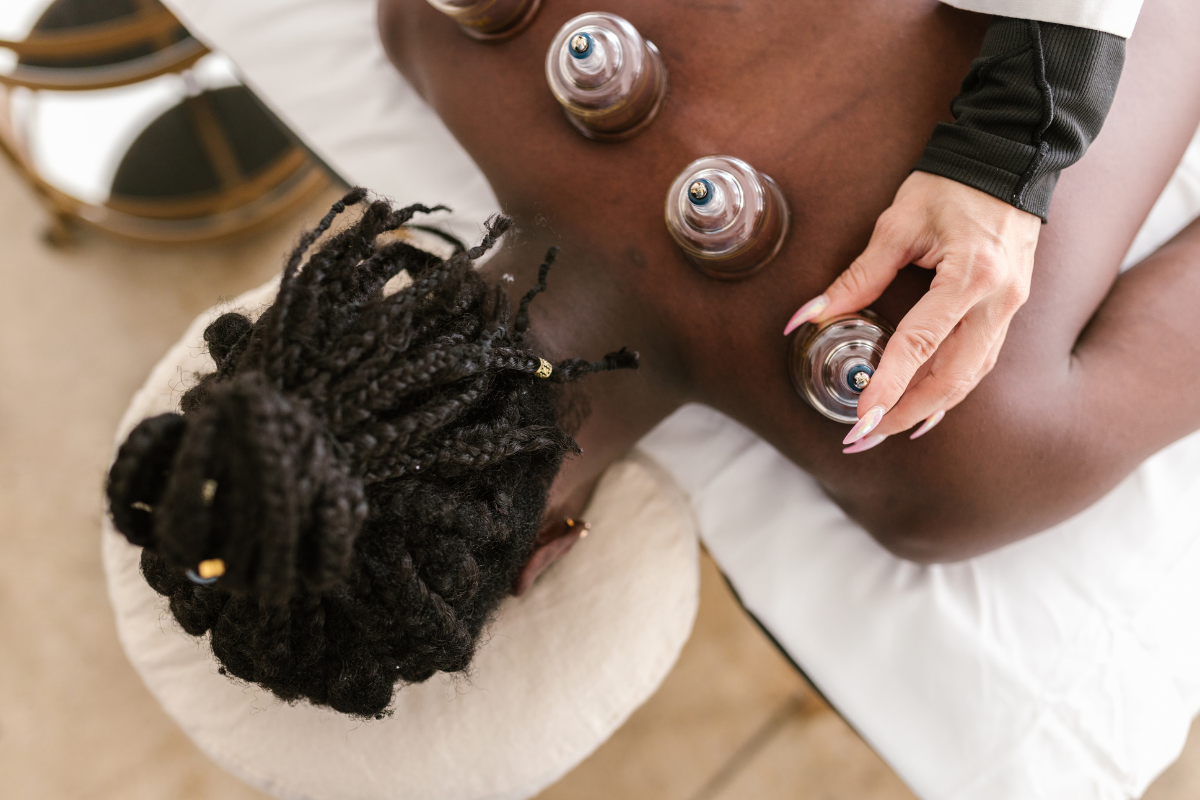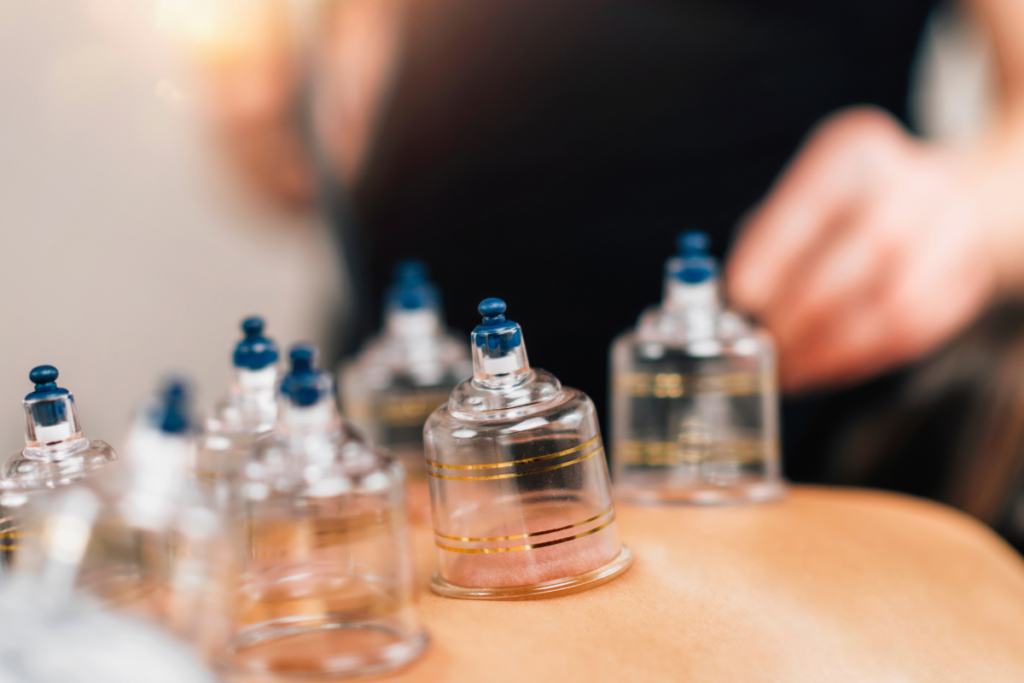The Benefits Of Cupping Therapy In Traditional Chinese Medicine
By: Daoyi Wellness
Cupping therapy has been practiced for thousands of years, and yet, its circular marks only recently made their red-carpet debut—literally.
From Olympic swimmers like Michael Phelps to wellness influencers across Toronto, cupping has become one of the most recognizable healing modalities rooted in Traditional Chinese Medicine (TCM).
Let’s get right into it!
Understanding Cupping Therapy
Cupping therapy is an ancient therapeutic technique that uses suction to stimulate blood flow, release tension, and promote healing. Practitioners place special cups on the skin—traditionally glass or bamboo, now often silicone or plastic—to create gentle vacuum pressure.
In Traditional Chinese Medicine, this suction is believed to unblock stagnant Qi (energy) and restore balance within the body’s meridian system. In modern terms, cupping enhances microcirculation, eases tight fascia, and supports the body’s natural recovery processes.
There are several types of cupping:
- Dry cupping: Standard suction without incisions.
- Wet cupping: Incorporates light skin pricks for controlled blood release.
- Moving cupping: The cups glide across oiled skin for massage-like effects.
- Fire cupping: Heated air inside glass cups creates a natural vacuum as it cools.
How Cupping Works On The Body
When the suction is applied, the skin rises slightly into the cup, creating negative pressure. This action helps:
- Increase blood flow to targeted areas
- Stimulate lymphatic drainage
- Loosen fascia and muscle fibres
- Trigger the body’s healing response
A 2019 study published in the Journal of Traditional and Complementary Medicine found that cupping significantly reduced chronic back pain intensity in adults, supporting its role as an effective adjunct therapy for pain management.
Key Benefits Of Cupping Therapy
Pain Relief
Cupping helps ease muscular pain by breaking up adhesions and stimulating deeper tissue circulation. It’s particularly effective for neck, shoulder, and lower back pain, as well as tension headaches.
Improved Circulation
By drawing fresh, oxygenated blood to affected tissues, cupping promotes healing and reduces inflammation—similar to deep tissue massage but with added suction power.
Stress Reduction
Cupping relaxes the parasympathetic nervous system, lowering heart rate and cortisol levels. Clients often describe post-session calmness similar to meditation.
Detoxification
The therapy aids lymphatic flow, helping the body eliminate waste and toxins more efficiently.
Enhanced Recovery For Athletes
Athletes use cupping to speed up muscle recovery and reduce soreness after training. Studies show improved flexibility and decreased lactic acid buildup post-treatment.
Skin Health
Cupping improves circulation to the skin, which can help with conditions like acne, cellulite, and eczema. Increased blood flow supports collagen production and tissue repair.
Scientific Research Supporting Cupping
While cupping’s roots are ancient, modern science has begun validating its benefits. Clinical research suggests that cupping may reduce pain, improve mobility, and decrease inflammation biomarkers.
According to a 2015 systematic review in PLOS One, cupping demonstrated positive results for pain management, herpes zoster, and acne, though researchers called for more large-scale studies.
The growing number of physiotherapy and sports clinics offering cupping indicates its acceptance as a complementary treatment in modern medicine.
What To Expect During A Cupping Session
A typical session begins with a brief consultation about your health history. The therapist then applies oil to the skin before placing the cups on specific points. The suction lasts for 5–15 minutes per area.
During treatment, you may feel a gentle pulling or warmth, not pain. Afterward, circular marks—ranging from pink to deep red—often appear. These aren’t bruises but signs of increased blood flow and minor capillary dilation. They fade within 3–7 days, depending on skin type and intensity.
Who Can Benefit From Cupping Therapy
Cupping is suitable for:
- Office workers with chronic tension
- Athletes seeking faster recovery
- Individuals with fibromyalgia, arthritis, or chronic fatigue
- Those experiencing anxiety or insomnia
However, people with bleeding disorders, skin infections, or who are pregnant should consult a healthcare professional before treatment.
Cupping Therapy Vs Other TCM Treatments
Cupping often complements acupuncture and gua sha, forming a powerful trio in TCM. While acupuncture stimulates energy points with needles, cupping targets larger surface areas to enhance blood and Qi flow. Many clinics combine both for holistic healing and muscle restoration.
Modern Adaptations Of Cupping
Contemporary clinics have evolved cupping beyond tradition. Silicone cups allow for adjustable suction, while magnetic cups integrate bio-stimulation technology. Many Canadian RMTs and physiotherapists now include cupping in treatment plans, blending Eastern techniques with Western rehabilitation science.
Celebrity use has also popularized the therapy—Michael Phelps, Gwyneth Paltrow, and Jennifer Aniston have all flaunted the signature circular marks, helping normalize and modernize the ancient art.
Conclusion
Cupping therapy bridges the gap between ancient wisdom and modern wellness. By promoting circulation, relieving pain, and calming the mind, it offers a natural, non-invasive way to restore balance.
Whether you’re in Toronto or elsewhere in Canada, seek a certified practitioner trained in TCM or registered massage therapy to ensure safe and effective sessions.
Cupping isn’t just a trend—it’s a timeless healing ritual revitalized for today’s wellness generation.
Frequently Asked Questions
What Are The Circular Marks From Cupping?
They’re temporary signs of increased blood flow and minor capillary expansion—not bruises.
Does Cupping Hurt?
Most people feel mild pressure or warmth. It shouldn’t be painful when done correctly.
How Long Do The Marks Last?
Typically 3–7 days, depending on skin type and treatment intensity.
Can Cupping Help With Anxiety?
Yes. By calming the nervous system and improving circulation, cupping can help reduce stress and anxiety symptoms.
Is Cupping Safe For Everyone?
It’s generally safe when performed by a trained professional, but people with certain medical conditions should consult a doctor first.
How Often Should I Get Cupping Therapy?
For general wellness, once every 2–4 weeks. For pain relief, your therapist may recommend weekly sessions initially.
What’s The Difference Between Dry And Wet Cupping?
Dry cupping uses suction only, while wet cupping involves light skin pricks for blood release in specific cases.
Can I Exercise After A Cupping Session?
It’s best to wait 24 hours to allow your body to recover.
How Should I Prepare For A Cupping Appointment?
Stay hydrated, eat a light meal, and avoid heavy exercise right before your session.
Is Cupping Covered By Insurance In Canada?
If performed by a Registered Massage Therapist (RMT) or TCM practitioner, many extended health plans may cover it.


